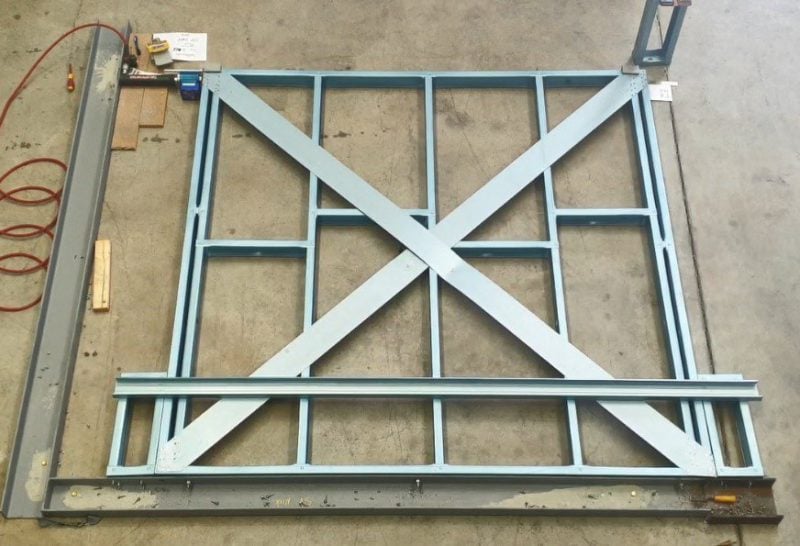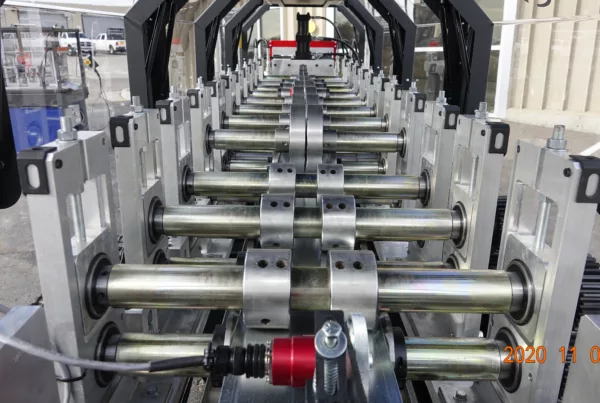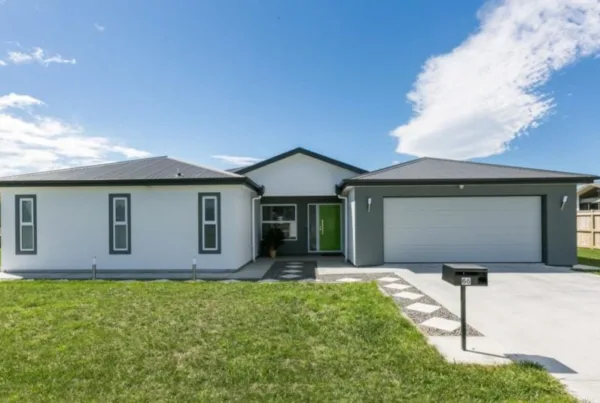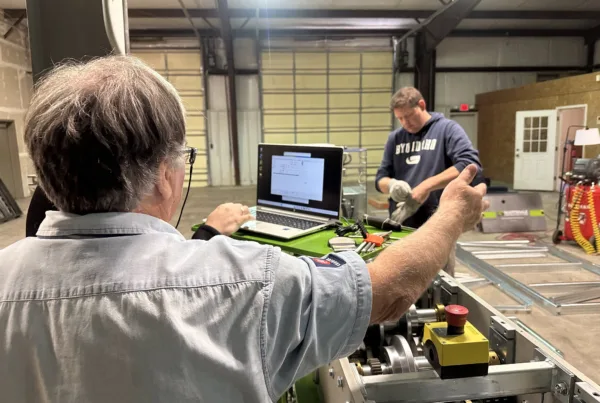- Develop a comprehensive project plan,
- Model the lateral bracing systems,
- Conduct detailed structural analysis,
- Design and review testing scenarios, and
- Document and report the results.
These findings are now available to the Scottsdale network of fabricators. The analysis and testing revealed that 150mm strap bracing delivers a capacity of 15kN, far outperforming traditional methods such as K-bracing, which provides only 1kN capacity. In addition to its superior strength, strap bracing is significantly more cost-effective, as it can be fabricated using offcuts from the mother coil. Bracing plays a critical role in the structural integrity of light-gauge cold-formed steel buildings, where builders often rely on a mix of strap bracing, K-bracing, and bracing boards to meet design and performance requirements.
Compared to structural steel, light gauge steel is lighter, easier to handle, and faster to install, making it the preferred choice for many builders. The flexibility of cold-formed steel also allows for easy customization to suit a wide range of building designs and configurations. Details of the study, testing program, and results are shared below.

Using Multiple Bracing Types on One Project
Can builders get cumulative capacity when using different bracing types? Different bracing types have varying ductility levels; therefore, they don’t often work effectively together. When one bracing system reaches its full capacity, the other may not engage as intended. Despite this, some builders still combine multiple bracing types when higher capacity is needed, which can lead to inefficiencies or underperformance. However, builders continue to turn to cold-formed steel for its many advantages, including strength, consistency, and design flexibility.
When Bracing Demands Exceed Wall Space
How can structural stability be achieved when bracing demands exceed available wall space? Many builders choose K-bracing because it can fit into narrow wall cavities as small as 450 mm. But does it truly deliver the required structural capacity? When considering both labor and material costs, the answer is no. K-bracing has high ductility and can deflect significantly under even a 1kN load, resulting in minimal usable capacity. In contrast, strap bracing offers far superior performance at a lower cost. As a result, K-bracing is not a recommended solution. This highlights the critical importance of designing tracks and optimizing roller placement in the roll forming process to ensure efficient, high-performance bracing systems.
Determining the Best Bracing Option
Rethinking Bracing Through Testing
Data from other regions, particularly the U.S., shows that there are more effective ways to resist lateral loads than using K-bracing. This insight prompted the development of a testing program to identify the most efficient bracing method. The first step was to document and prepare a series of tests comparing the performance of K-bracing, 30mm strap bracing, 150mm strap bracing, and plywood.
Engineering and Testing Program
For this test program, we engaged Thanuja Ranawaka as our in-house engineer alongside the third-party firm Eiger Engineering. Scottsdale selected to use 150mm straps as cross bracing, as they can be sourced cost-effectively from off-cuts of the mother coil. Initially, discussions with various consulting engineers were met with skepticism regarding this approach. However, these conversations also provided an opportunity to highlight the benefits of roll forming and its broader industry applications. To validate our concept, we conducted structural tests demonstrating that 150mm strap bracing can carry significant loads. Test specimens fabricated were 2.4m x 2.4m wall panels constructed with C90_37_0.75 wall studs.
Key Findings and Structural Implications
Our testing confirmed that 150mm strap bracing can withstand a horizontal load of 15kN. Neither the strap nor the connections failed; in fact, the failure occurred in the wall members themselves. This indicates that using thicker wall studs, such as 0.95mm material, could result in even higher load capacities. These findings also underscore the critical role of sheet steel in the roll forming process, where precise material selection and profile shapes are essential to structural performance.
Summary of Strap Bracing vs. K-Bracing Test Results
Based on the results of our analysis and testing, Scottsdale confidently recommends 150mm strap bracing as a highly effective solution, demonstrating a capacity of 15kN compared to just 1kN from K-bracing or other traditional methods. This approach proved successful in collaboration with AFS.
If you have similar engineering requirements, we invite you to contact Scott Kimble to discuss a customized analysis and review by our Engineering team. Email: scott.kimble@scottsdalesteelframes.com.
Benefits of Cold-Formed Steel
The advantages of using factory-manufactured panels in construction include quicker assembly and reduced need for skilled labor. The roll forming process is efficient in creating complex profiles, making it suitable for various applications. Light-gauge steel framing is relevant in terms of efficiency and workflow on job sites. The importance of fasteners in securing steel components together cannot be overlooked.
Roll Forming Process and Design Flexibility
The simplicity of roller designs in the roll forming process allows for versatility and adaptability. Designers play a crucial role in utilizing cold-formed steel panels and steel trusses effectively. Tracks are essential in the assembly of steel sections, ensuring stability and strength. The use of sheet metal in the roll forming process allows for the creation of precise and consistent shapes. Metal strips are integral to the roll forming process, contributing to the efficiency and precision of the final product. The creation of complex profiles through the roll forming process highlights its advantages. The energy efficiency of the roll forming process is another significant benefit. Thin sheets of steel are passed through machines like roll formers to achieve the desired shapes.
Compliance, Standards, and Efficiency
Adhering to industry standards and terms is crucial for ensuring safety and compliance. The fact that light-gauge steel farming offers numerous advantages is well-documented. Potential customers might be interested in exploring the benefits of light-gauge steel framing. The precision and consistency in producing various shapes with light-gauge steel are noteworthy. The logistics of transporting completed steel components to the job site are streamlined. Specific cases where rollers function as precision contouring dies highlight the complexity of the process. Specific techniques are tailored based on project needs to ensure optimal results.
Cold-Formed Steel vs. Hot-Rolled Steel
The differences between cold-formed steel and hot-rolled steel in terms of heat application are significant. Roll forming machines play a vital role in shaping thin steel sheets. Discussing needs with potential clients helps with understanding and meeting their requirements. The hot-rolling process involves heated steel, which contrasts with the cold-forming process. The limitations of conventional stamping processes are overcome by roll forming. The use of thin sheets of steel in the manufacturing process is advantageous.
Professional Expertise and Industry Support
Access to skilled professionals in cold-formed steel framing is a significant benefit. The American Iron and Steel Institute’s standards guide the use of steel in construction. The advantages of using metal in construction are numerous. Light-gauge steel offers superior resistance compared to wood framing. The logistical advantages of shipping cold-formed steel are evident. The typical characteristics of structural steel components are well-understood. Programming roll former machines is essential for achieving the desired results. Cold-formed steel is resistant to termites, adding to its durability. The advantages of light-gauge steel in construction are clear.
Learn more about roll forming cold-formed steel members and Scottsdale’s solutions by viewing our video.
Light-Gauge Steel Framing Systems
Light-gauge steel framing systems are a specialized type of steel framing method that employs cold-formed steel sections to construct a building’s structural framework. These systems are ideal for both commercial and residential construction projects, offering unparalleled durability and efficiency. Designed to meet the specific needs of each project, light-gauge steel framing systems take into account critical factors such as load, safety, and accessibility.
The use of light-gauge steel framing systems can help reduce construction costs and time, while also providing a high level of precision and accuracy. These systems are environmentally friendly, as they are made from recyclable materials and can be easily dismantled and reused. Additionally, their lightweight nature makes them easy to ship, handle, and assemble on construction sites, contributing to overall efficiency and cost-effectiveness. Light-gauge steel framing systems are versatile, suitable for a wide range of applications including wall panels, floor systems, and roof systems.
The process of designing and installing light-gauge steel framing systems with the right tools and expertise requires minimal training and equipment. The benefits of light-gauge steel framing systems are numerous, including their ability to withstand heavy loads, provide excellent fire resistance, and offer a high level of durability and efficiency.
Contact Us for Your Roll Forming Needs
If you’re considering using cold-formed steel in your future projects, reach out to us at sales@scottsdalesteelframes.com, or call +1 (888) 406-2080 (Option 1) or +61 1300 671 345. Our team of experts is ready to support you in setting up your own cold-formed steel manufacturing facility and ensuring a seamless transition to steel framing.






